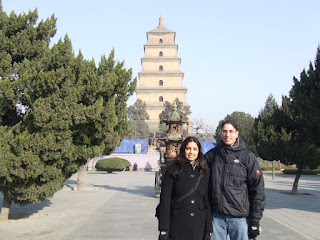 We caught a tour to the Terracotta warriors, which consisted of the same process as that which we had endured for the Great Wall – visit one or two secondary sites, visit souvenir factories, have lunch, then finally get to the main attraction. However, this time round things felt like they took forever, perhaps because there were more people in our group and the ensuing cat-herding took more time.
We caught a tour to the Terracotta warriors, which consisted of the same process as that which we had endured for the Great Wall – visit one or two secondary sites, visit souvenir factories, have lunch, then finally get to the main attraction. However, this time round things felt like they took forever, perhaps because there were more people in our group and the ensuing cat-herding took more time.And of course, nothing was heated. Not the Wild Goose Pagoda we visited (built by the emperor to honor his mother), not the Banpo archeological site, not the souvenir factory, not even the place where we had lunch. I’m not sure if this is a way to cut down on costs, or if the locals just don’t feel as cold as the tourists. I’m more likely to believe the latter, since I’ve seen people without gloves or hats on, merrily working away at whatever outdoor tasks they have. And today was especially cold. The souvenir store this time round was more noteworthy than the one during our Great Wall visit. Viagra was available for purchase.
We did not arrive at the terracotta warriors until late afternoon, but it was worth the wait. Row upon row of statues, wearing different expressions and intricate carvings. The structure they were housed in was a massive hangar, and our guide told us that there were over six thousand in that hangar alone. There were two other such hangars, and several areas had not been dug up yet – I would hazard that ten thousand of these warriors lie interred, which just boggles the mind. What better proof of an emperor’s power is there than to commission such a massive project, and then just bury the masterpiece underground?
Incidentally, the farmer who discovered the warrior pits was at the terracotta warrior museum – there was a big picture of him up on the wall with some important dignitaries and with newspaper clippings, so you knew it was him. But the old man was just sitting at a table, waiting for you to pick up a guidebook (which you had to pay for), so that he could autograph it for you. I wonder what life must be like for him now. You dig a well to water your farm, discover a national treasure, are deprived of your land, and then are made to sit around on a daily basis signing autographs for tourists. Not exactly the career he could have envisioned for himself.Outside the warrior hangar I came across an interesting sign. The government is expanding and modernizing the site to take on the flood of visitors expected in 2008 for the Olympics, so everything looks new and shiny, including the trash cans. I had trouble figuring out the concept of "Unrecycling" though. What exactly does that mean?
That night back at the hotel we decided to head to the Muslim quarter again, not for food but to check out the Great Mosque, which everyone spoke of highly. As we walked through winding alleyways, we encountered groups of young men playing with what can only be described as a cross between a hacky-sack and a badminton shuttle cock. Each person would kick this contraption high into the air, and as it descended, whoever was closest to it would it hit it back up again without using their hands. This continued indefinitely, large circles of boys continuously entertaining themselves.
Unfortunately the mosque was closed, which struck as odd for a place of worship. Worse still, there was no artificial lighting in the alleys, and so Saeeda and I had to navigate back out in pitch darkness, crossing empty alleys and cul-de-sacs. Not the smartest decision on our part, but we made it out fine. We were rewarded at the end of our journey when we chanced upon a huge outdoor market that sold all sorts of fresh fruit . The colors were beautiful.
Safety in





Yes, it is always jarring to hear the HHHACCCKKKKIISH as the person behind you is dredging their throat. . . .
ReplyDeleteDo be careful with your stuff though, one of the guys on our trip to Shanghai was pickpocketed on the metro.
This is a little late since you guys have already been shopping, but try picking up a calculator - any cheap one would do. They are great for bargaining and haggling, since you can say what you are willing to pay despite not being able to speak the language.
ReplyDeleteI am loving the stories!
This is awesome! Keep us posted - I love the pictures! I would start a blog from Chicago, but somehow it just isn't the same...
ReplyDeleteKristin Z